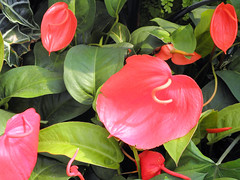Anthurium Scherzerianum Plant Care
Scherzerianum (or Pig-Tail Anthurium) are a beautiful breed of anthurium plant that produces red, orange or pink flowers. What sets them apart from Andraeanum is their spadix. They have a curly spadix, rather than a straight one like Andraeanum. Since they are closely related to Andraeanum, Anthurium Scherzerianum Plant Care is really not very different than what is required for Andraeanum.
I suppose that the main difference between the species is that Scherzerianum is a bit better adapted as a houseplant so they are in fact a little easier to care for.
Temperature
The ideal temperature for it is 80 degrees. Ideally, it should not be exposed to temperatures below 60 degrees or above 90 degrees. Temperatures below 60 degrees will hinder growth and flowering, while temperatures above 90 degrees can cause damage to flowers and leaves. Freezing temperatures are to be avoided at all costs, since exposure to frost can be deadly.
Light
Bright, indirect sunlight is best. But direct exposure to midday sun can burn leaves and foliage, so make sure that it is never exposed to strong, direct sunlight. If your plant is near a window with direct sun, cover the window with a thin, filmy curtain to block a portion of the light. If your plant receives too little light, it may stop flowering. A tell-tale sign of insufficient light is a plant that produces a lot of dark green leaves and no flowers.
Potting Soil
Any loose, well drained soil will work well. If you have access to volcanic cinder, you can use it. If not, you can use a mix that has bark, moss and perlite. The key is to make sure that your potting soil drains well. Excessive moisture can cause root rot and other problems that may harm your plant.
Watering
Water your plant regularly, but make sure that the water drains out of the pot quickly. In the rainforest, these plants grow up the side of trees. Despite receiving daily water from rain, their roots are never soaked in water because the water drips down the side of the tree and away from their roots. Since your plant is in a pot, you need to make sure that all of the water drains out of the pot and the potting soil dries slightly, but not completely, before watering again.
Humidity
Humidity should be high, but not excessive. Somewhere around 70 to 80% is ideal. Any higher and fungal issues may occur. Down to 50% is generally fine. But you may want to mist the leaves once and a while. Mist the leaves in the morning and make sure that they dry by the evening to prevent fungal problems. If they don’t dry by the evening, this means that your humidity is more than enough and you don’t need to mist your plants. At this level of humidity good air circulation is essential to prevent the growth of fungus.
Anthurium Scherzerianum: An Excellent Anthurium Plant With A Funny Name
Anthurium Scherzerianum that just rolls off the tongue, doesn’t it? I know, it’s a very long and funny name for such a remarkable plant. It is also known as the Flamingo Flower. It produces lovely flowers that can be red, orange or reddish-orange. Its most distinctive feature is that it produces a spadix that is curlier than a pig’s tail. So why is it called the flamingo flower instead of the pig flower? Who knows?
Basic Facts
Family: Araceae
Genus: Anthurium
Species: Scherzerianum
Latin name: Anthurium scherzerianum
Common name: Flamingo Flower
Climate: Tropical
Minimal temperature: 59-64°F, reduce watering at these temps
Best temperature: 78-86°F
Recommended place: bright morning or evening light, with partial shade
Soil: peat-humus, porous, loose
Flower color: red, orange or reddish-orange
Repotting Frequency: every 2 years
Country Of Origin: Costa Rica
Background Information
This species is originally from Costa Rica where it grows in rain forests. It is grown all over the world and there are now more than forty cultivars. The easiest way to distinguish this species from the Andraeanum species is to look at the spadix. The spadix of Andraeanum is straight, while the spadix of the Scherzerianum is very curly.
Growing Conditions
The Flamingo Flower likes tropical conditions, but it can also tolerate winter as long as it is kept above 65 degrees, though the ideal temperature for it is 75 to 85 degrees. It prefers high humidity and a great deal of moisture, but you must be careful of standing water, which can cause root rot. If you live in a dry climate, misting it twice a day can provide the humidity that it requires. It also requires partial shade, full sunlight can burn it. But if the light is insufficient it will grow slower and produce few flowers. During the cooler times of the year, you should reduce the amount of water that you give it.
Propagation
There are three ways to propagate this species. The first and easiest method is via cuttings. These plants can be cut in half, provided that each half retains three or more growing nodes and each half will continue to grow if potted separately. The second and slightly more difficult method is via seeds. Creating seeds will usually require manual pollination. If you only have one plant, self pollination is possible if you are willing to store pollen in the freezer, though it takes much longer to propagate via seed. Seeds do not keep for very long, so you have to plant them as soon as they ripen. Finally, if you have a lab, you can also propagate these plants with tissue culture, but this is definitely beyond the reach of most enthusiasts.
A Common Mistake
The “flower” is not really the flower of these plants. It is a modified leaf or spathe. It is essentially a leaf that is a different color. The true flower of the plant is found on the spadix or nose of the “flower”. The spadix holds microscopic inflorescences which consist of the both the stigma and the stamen of these plants. These flowers are perfect in that each flower has male and female parts; however, these parts are active at different times, so self pollination rarely occurs without human help and the storage of pollen in the freezer until the stigma is ready to be fertilized.


